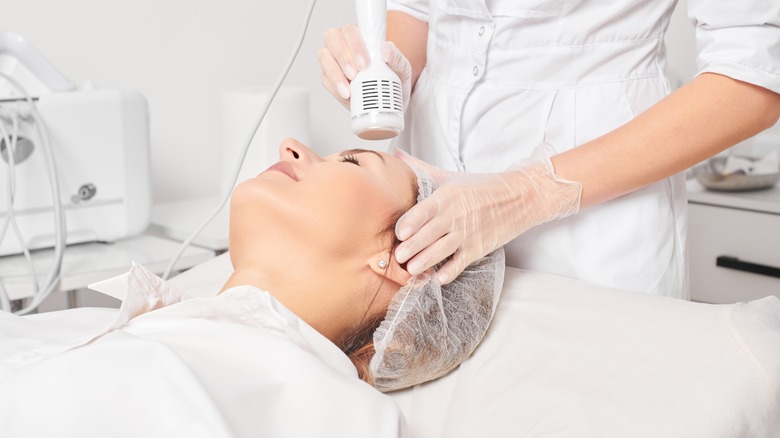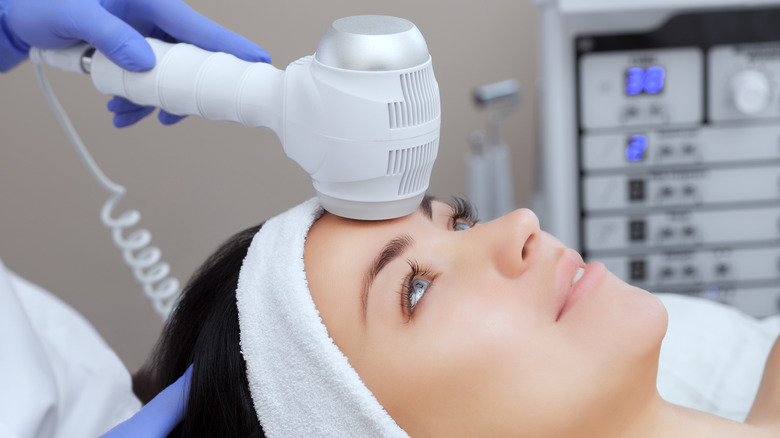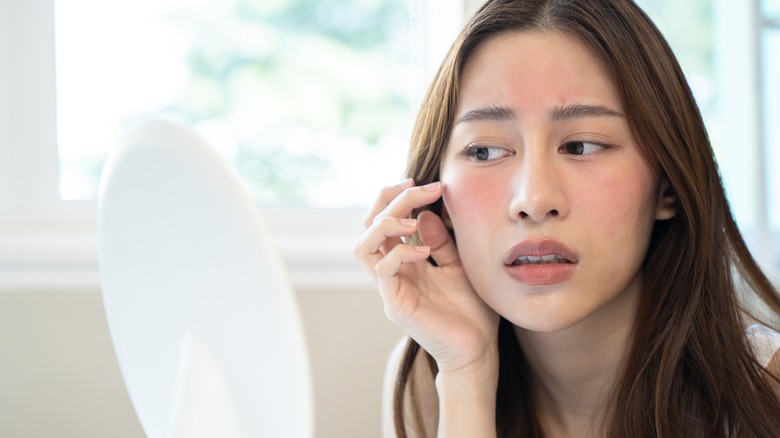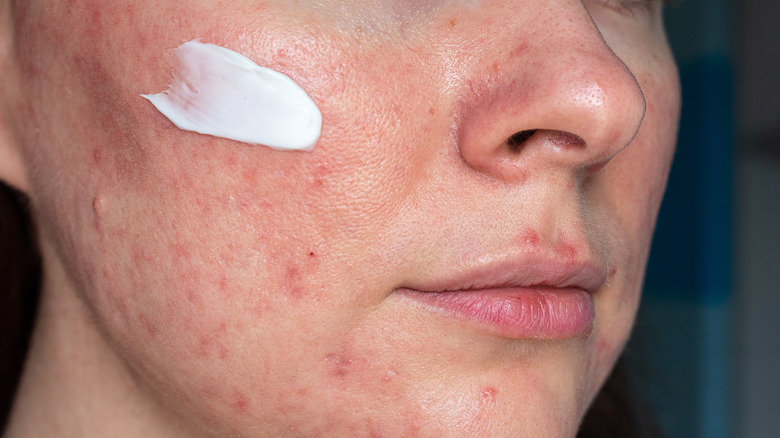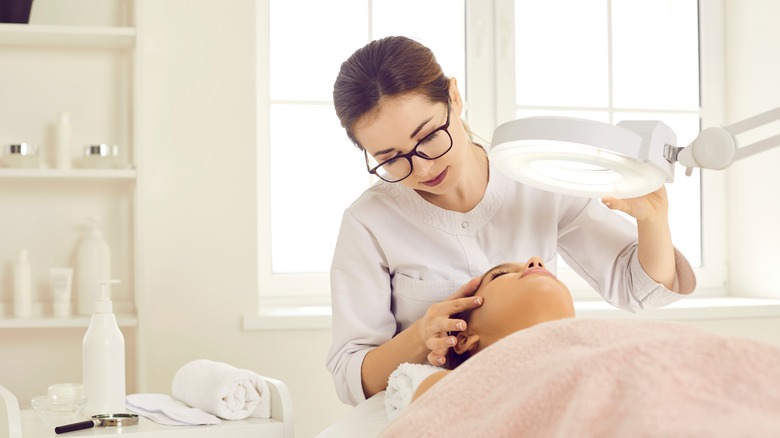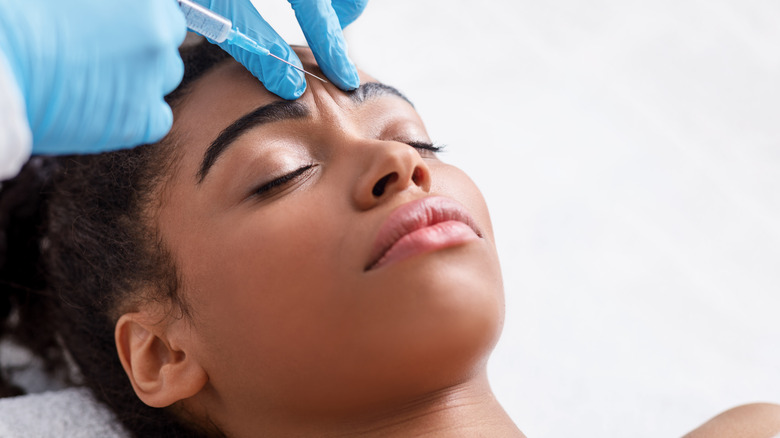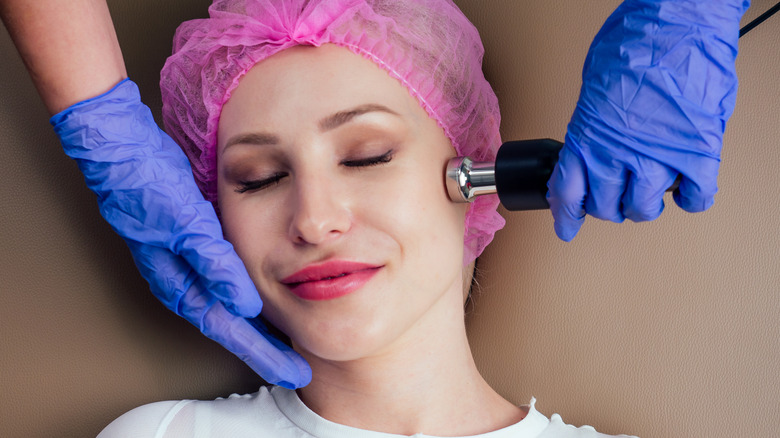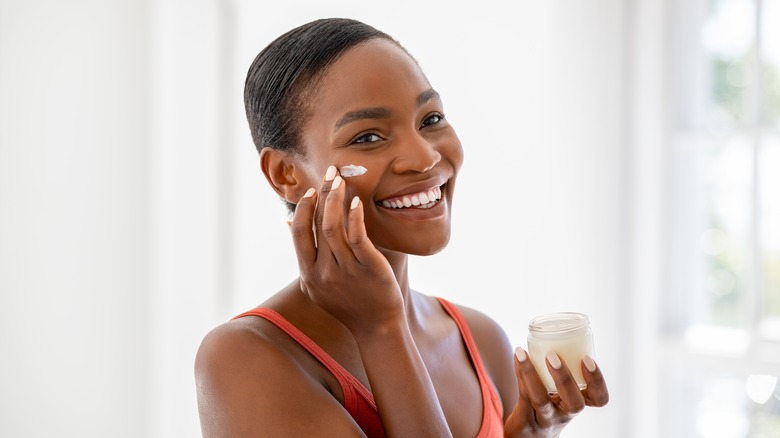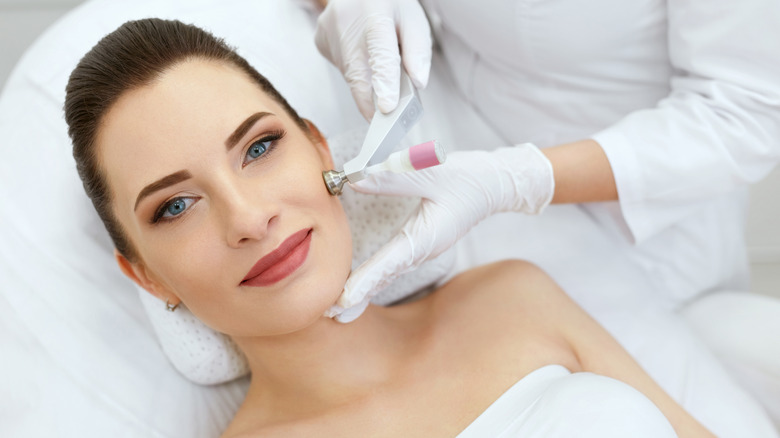Glacial Rx: What To Know About The Cool New Face Treatment
For years, doctors and estheticians have been harnessing the power of extreme cold to help freeze unwanted tissue and even treat certain types of cancers. Most of these cryotherapy treatments involve spraying the skin or abnormal tissue with liquid nitrogen, liquid nitrous oxide, or argon gas brought to an extremely low temperature, essentially killing and freezing away the dangerous or unsightly tissue.
Small-scale applications of this for aesthetic purposes are frequently used in-office and at home with freeze-away wart removers, but Glacial Rx takes a more large-scale and gentle approach to this technology. Instead of focusing on removing tissue, this treatment is used to fight inflammation and leave you with an overall more glowy, smooth complexion — something more similar to a facial than an involved medical procedure. Essentially, Glacial Rx is the next step to trendy ice rollers and ice therapy, but it's still important to do a bit more research than you would walking to your freezer to find a way to de-puff.
What is Glacial Rx?
Glacial Rx is a name-brand treatment that toes the line between intensive cryotherapy and simple ice rolling. This treatment uses a trademarked Cryomodulation algorithm to customize the level of cooling to suit your skin's needs, resulting in an ultra-precise and targeted treatment individual to each patient. Additionally, there are three interchangeable heads on the machine that can be used either alone or in conjunction, allowing your aesthetician further to cater the results to your desired final effect.
Each head uses the same customizable level of cooling but with three different application methods. The first is cooling and dermabrasion, which focuses on all-over exfoliation and treatment to help remove dead skin. The second is continuous cooling, used to treat inflammation and calm skin facing flare-ups or redness. Finally, there's precision freezing, which is more similar to freezing off a wart. This is used for ultra-specific areas on the face that include benign lesions.
What is it used for?
Glacial Rx is primarily used to decrease inflammation, encourage exfoliation, improve skin texture, tighten sagging or crepey skin, and reduce the appearance of lesions. Essentially, the goal is to leave you with a smoother, brighter, healthier complexion. It can also decrease the swelling and discomfort from other treatments, numbing redness and stressed skin as the result of heat or laser-based treatments and helping decrease the healing time.
While the most popular application of Glacial Rx is on the face, the brand also states that the device is safe for use anywhere on the body, which is especially helpful for skin-tightening and inflammation-decreasing applications. Essentially, this treatment's goal is to make your skin look as healthy, glowy, and tight as possible while still giving you the ability to leave the office feeling and looking your best — no downtime or invasive treatments necessary,
Who are the best candidates?
Glacial Rx's main draw and what sets it apart from other treatments is its ability to minimize inflammation. Because of this, it's a great choice if you're still suffering the consequences of another therapy or are facing an uncomfortable sunburn. It's also a solid option for those dealing with more consistent skin redness due to acne or rosacea, as it will provide some much-needed cooling relief and an overall blemish-free look.
Glacial Rx won't yield the same results as Botox or more intensive plastic surgery. Still, it's an excellent choice for those looking for subtle anti-aging effects like tightening the skin and reducing the appearance of skin discoloration and spots that have developed due to sun exposure and age. For people not looking to treat a specific issue, it can also act as a basic exfoliating and brightening treatment, helping to make your skin look luminous and smoother.
How to find a provider
This form of cooling treatment is still relatively rare amongst the sea of microdermabrasion and chemical peels on the market. However, Glacial Rx has made it easy to find an officially licensed provider near you with a convenient locator on their website. All you need to do is enter your zip code and search radius, and the website will provide you with a list of spas that offer Glacial Rx treatments near you.
Unfortunately, however, offices that offer this remedy are pretty few and far between, especially if you don't live near or in a major city, so it might take a bit of waiting for the trend to catch up. You may even have to travel to find a practitioner that offers Glacial Rx treatments. If trends in larger cities are a hint at what's to come across the country, however, you're in luck — Los Angeles already has seven locations in the area.
How to prepare for a treatment
If you were able to find a provider, luckily, that's pretty much where your prep work ends. This procedure isn't invasive and doesn't involve using additional products or chemicals, so basically, all you need to do is show up. Skip the makeup for the day so you can avoid removing it before your treatment, and you're good to go.
It should be said, however, that if you're currently using a retinoid, you should take a break for a few days prior to your appointment, especially if you're undergoing the cooling and dermabrasion approach for all-over exfoliation. Doubling up on a retinoid and a slightly harsher exfoliating treatment could leave your skin feeling a bit raw and sore once you leave the office. Additionally, you should wait about two weeks after getting filler, botox, or injection of another neurotoxin to allow any swelling and bruising to go down.
What to expect during a treatment
During your treatment, your practitioner will begin by looking at your skin and discussing your goals for the session. Once you've developed a plan, they'll go in with one of the three modalities — cooling and dermabrasion, continuous cooling, or precision freezing. These modalities can be mixed and matched during your appointment, or you can focus on just one.
From there, it will all depend on your specific plan of action. The dermabrasion approach could be slightly uncomfortable, as with any in-office exfoliating treatment, but the cooling should help temper any stinging you might feel. However, if you go for continuous cooling, there shouldn't be any discomfort — the wands glide across your skin. Cryotherapy and extreme cold seem intimidating at first glance. Still, this procedure should be more relaxing than anything else, and you should leave your appointment feeling bright and refreshing rather than swollen or irritated.
How to take care of your skin after a treatment
After your treatment, your skin should feel glowy and smooth, but it could be sensitive to products with more active ingredients after exfoliation. Because of this, it's important to focus on moisturization, simple ingredients, and repairing your skin barrier. A simple routine of cleanser, moisturizer, and sunscreen is likely all you'll need in the following few days, though you may feel more sensitivity and face a bit of healing time with the precision freezing spot treatment. Once these spots have healed, the skin will naturally slough off, so it's best to avoid harsh scrubbing and ingredients in that area until your skin has regenerated.
As you leave your appointment, your practitioner might give you a special cream or serum to help this process. Still, you're free to resume your regular skincare routine, workouts, and makeup application once your skin feels good, especially if you opt for cooling and dermabrasion or continuous cooling treatment.
Potential side effects
Luckily, this procedure doesn't carry many side effects. Because it's all about using extreme temperatures to improve your skin's health, it doesn't require using any products or ingredients you could be allergic to. The only thing you really have to look out for is healing times with spot treatment, which could leave you feeling less than your best for a few days, but you shouldn't be facing any pain or intense discomfort once you head home, especially if you just went in for an all-over treatment.
Of course, however, monitoring your skin's health after a professional aesthetic treatment is still important, especially if you couple Glacial Rx with other procedures in the same time frame. If you notice any swelling, pain, rashes, or signs of infection, head to the doctor right away. It's always better to be safe than sorry when it comes to taking care of your skin.
How much does it cost?
As with any treatment that promises the sought-after combination of tangible results and no downtime, Glacial Rx can be pretty expensive, especially for something more akin to a facial than an involved aesthetic procedure. The final cost depends on the type of treatment, location of the medical spa, and general pricing of their other treatments, but it's usually around $350 to $675 per session. This can also vary based on whether you couple Glacial Rx with other treatments like Fraxel, a popular choice to guarantee results while tempering redness and swelling.
Most people see results after one treatment, but the impacts develop and fade over time, so keeping consistent with the glowy, even look might mean paying for additional follow-up touch-ups. The time between recommended appointments varies based on the client, but most will see peak results after about three months since their initial appointment.
